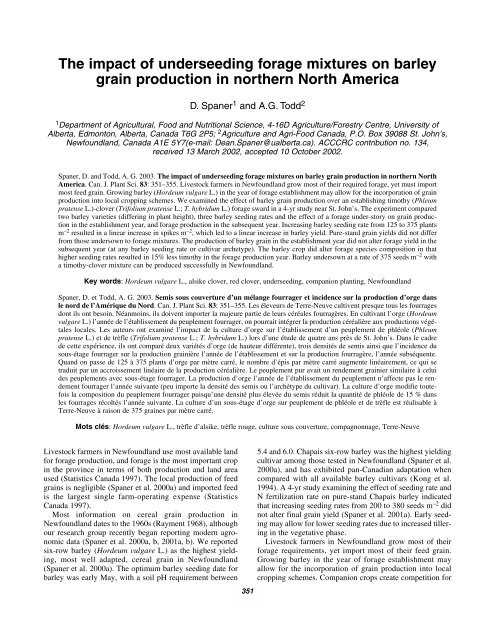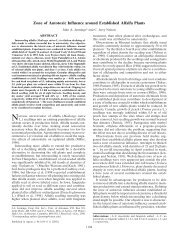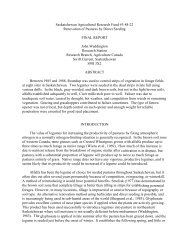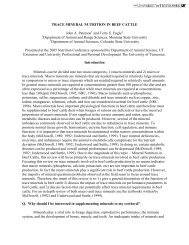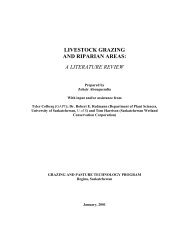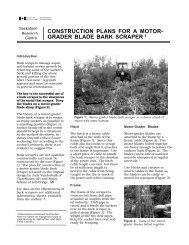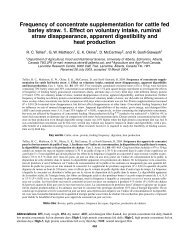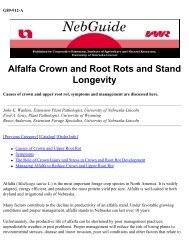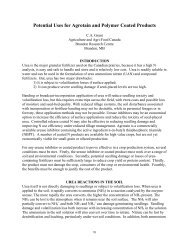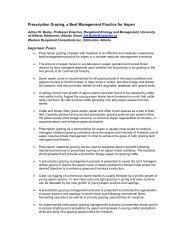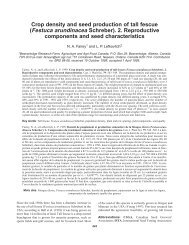The impact of underseeding forage mixtures on barley grain ...
The impact of underseeding forage mixtures on barley grain ...
The impact of underseeding forage mixtures on barley grain ...
Create successful ePaper yourself
Turn your PDF publications into a flip-book with our unique Google optimized e-Paper software.
<str<strong>on</strong>g>The</str<strong>on</strong>g> <str<strong>on</strong>g>impact</str<strong>on</strong>g> <str<strong>on</strong>g>of</str<strong>on</strong>g> <str<strong>on</strong>g>underseeding</str<strong>on</strong>g> <str<strong>on</strong>g>forage</str<strong>on</strong>g> <str<strong>on</strong>g>mixtures</str<strong>on</strong>g> <strong>on</strong> <strong>barley</strong><strong>grain</strong> producti<strong>on</strong> in northern North AmericaD. Spaner 1 and A.G. Todd 21 Department <str<strong>on</strong>g>of</str<strong>on</strong>g> Agricultural, Food and Nutriti<strong>on</strong>al Science, 4-16D Agriculture/Forestry Centre, University <str<strong>on</strong>g>of</str<strong>on</strong>g>Alberta, Edm<strong>on</strong>t<strong>on</strong>, Alberta, Canada T6G 2P5; 2 Agriculture and Agri-Food Canada, P.O. Box 39088 St. John’s,Newfoundland, Canada A1E 5Y7(e-mail: Dean.Spaner@ualberta.ca). ACCCRC c<strong>on</strong>tributi<strong>on</strong> no. 134,received 13 March 2002, accepted 10 October 2002.Spaner, D. and Todd, A. G. 2003. <str<strong>on</strong>g>The</str<strong>on</strong>g> <str<strong>on</strong>g>impact</str<strong>on</strong>g> <str<strong>on</strong>g>of</str<strong>on</strong>g> <str<strong>on</strong>g>underseeding</str<strong>on</strong>g> <str<strong>on</strong>g>forage</str<strong>on</strong>g> <str<strong>on</strong>g>mixtures</str<strong>on</strong>g> <strong>on</strong> <strong>barley</strong> <strong>grain</strong> producti<strong>on</strong> in northern NorthAmerica. Can. J. Plant Sci. 83: 351–355. Livestock farmers in Newfoundland grow most <str<strong>on</strong>g>of</str<strong>on</strong>g> their required <str<strong>on</strong>g>forage</str<strong>on</strong>g>, yet must importmost feed <strong>grain</strong>. Growing <strong>barley</strong> (Hordeum vulgare L.) in the year <str<strong>on</strong>g>of</str<strong>on</strong>g> <str<strong>on</strong>g>forage</str<strong>on</strong>g> establishment may allow for the incorporati<strong>on</strong> <str<strong>on</strong>g>of</str<strong>on</strong>g> <strong>grain</strong>producti<strong>on</strong> into local cropping schemes. We examined the effect <str<strong>on</strong>g>of</str<strong>on</strong>g> <strong>barley</strong> <strong>grain</strong> producti<strong>on</strong> over an establishing timothy (Phleumpratense L.)-clover (Trifolium pratense L.; T. hybridum L.) <str<strong>on</strong>g>forage</str<strong>on</strong>g> sward in a 4-yr study near St. John’s. <str<strong>on</strong>g>The</str<strong>on</strong>g> experiment comparedtwo <strong>barley</strong> varieties (differing in plant height), three <strong>barley</strong> seeding rates and the effect <str<strong>on</strong>g>of</str<strong>on</strong>g> a <str<strong>on</strong>g>forage</str<strong>on</strong>g> under-story <strong>on</strong> <strong>grain</strong> producti<strong>on</strong>in the establishment year, and <str<strong>on</strong>g>forage</str<strong>on</strong>g> producti<strong>on</strong> in the subsequent year. Increasing <strong>barley</strong> seeding rate from 125 to 375 plantsm –2 resulted in a linear increase in spikes m –2 , which led to a linear increase in <strong>barley</strong> yield. Pure-stand <strong>grain</strong> yields did not differfrom those undersown to <str<strong>on</strong>g>forage</str<strong>on</strong>g> <str<strong>on</strong>g>mixtures</str<strong>on</strong>g>. <str<strong>on</strong>g>The</str<strong>on</strong>g> producti<strong>on</strong> <str<strong>on</strong>g>of</str<strong>on</strong>g> <strong>barley</strong> <strong>grain</strong> in the establishment year did not alter <str<strong>on</strong>g>forage</str<strong>on</strong>g> yield in thesubsequent year (at any <strong>barley</strong> seeding rate or cultivar archetype). <str<strong>on</strong>g>The</str<strong>on</strong>g> <strong>barley</strong> crop did alter <str<strong>on</strong>g>forage</str<strong>on</strong>g> species compositi<strong>on</strong> in thathigher seeding rates resulted in 15% less timothy in the <str<strong>on</strong>g>forage</str<strong>on</strong>g> producti<strong>on</strong> year. Barley undersown at a rate <str<strong>on</strong>g>of</str<strong>on</strong>g> 375 seeds m –2 witha timothy-clover mixture can be produced successfully in Newfoundland.Key words: Hordeum vulgare L., alsike clover, red clover, <str<strong>on</strong>g>underseeding</str<strong>on</strong>g>, compani<strong>on</strong> planting, NewfoundlandSpaner, D. et Todd, A. G. 2003. Semis sous couverture d’un mélange fourrager et incidence sur la producti<strong>on</strong> d’orge dansle nord de l’Amérique du Nord. Can. J. Plant Sci. 83: 351–355. Les éleveurs de Terre-Neuve cultivent presque tous les fourragesd<strong>on</strong>t ils <strong>on</strong>t besoin. Néanmoins, ils doivent importer la majeure partie de leurs céréales fourragères. En cultivant l’orge (Hordeumvulgare L.) l’année de l’établissement du peuplement fourrager, <strong>on</strong> pourrait intégrer la producti<strong>on</strong> céréalière aux producti<strong>on</strong>s végétaleslocales. Les auteurs <strong>on</strong>t examiné l’<str<strong>on</strong>g>impact</str<strong>on</strong>g> de la culture d’orge sur l’établissement d’un peuplement de phléole (Phleumpratense L.) et de trèfle (Trifolium pratense L.; T. hybridum L.) lors d’une étude de quatre ans près de St. John’s. Dans le cadrede cette expérience, ils <strong>on</strong>t comparé deux variétés d’orge (de hauteur différente), trois densités de semis ainsi que l’incidence dusous-étage fourrager sur la producti<strong>on</strong> <strong>grain</strong>ière l’année de l’établissement et sur la producti<strong>on</strong> fourragère, l’année subséquente.Quand <strong>on</strong> passe de 125 à 375 plants d’orge par mètre carré, le nombre d’épis par mètre carré augmente linéairement, ce qui setraduit par un accroissement linéaire de la producti<strong>on</strong> céréalière. Le peuplement pur avait un rendement <strong>grain</strong>ier similaire à celuides peuplements avec sous-étage fourrager. La producti<strong>on</strong> d’orge l’année de l’établissement du peuplement n’affecte pas le rendementfourrager l’année suivante (peu importe la densité des semis ou l’archétype du cultivar). La culture d’orge modifie toutefoisla compositi<strong>on</strong> du peuplement fourrager puisqu’une densité plus élevée du semis réduit la quantité de phléole de 15 % dansles fourrages récoltés l’année suivante. La culture d’un sous-étage d’orge sur peuplement de phléole et de trèfle est réalisable àTerre-Neuve à rais<strong>on</strong> de 375 <strong>grain</strong>es par mètre carré.Mots clés: Hordeum vulgare L., trèfle d’alsike, trèfle rouge, culture sous couverture, compagn<strong>on</strong>nage, Terre-NeuveLivestock farmers in Newfoundland use most available landfor <str<strong>on</strong>g>forage</str<strong>on</strong>g> producti<strong>on</strong>, and <str<strong>on</strong>g>forage</str<strong>on</strong>g> is the most important cropin the province in terms <str<strong>on</strong>g>of</str<strong>on</strong>g> both producti<strong>on</strong> and land areaused (Statistics Canada 1997). <str<strong>on</strong>g>The</str<strong>on</strong>g> local producti<strong>on</strong> <str<strong>on</strong>g>of</str<strong>on</strong>g> feed<strong>grain</strong>s is negligible (Spaner et al. 2000a) and imported feedis the largest single farm-operating expense (StatisticsCanada 1997).Most informati<strong>on</strong> <strong>on</strong> cereal <strong>grain</strong> producti<strong>on</strong> inNewfoundland dates to the 1960s (Rayment 1968), althoughour research group recently began reporting modern agr<strong>on</strong>omicdata (Spaner et al. 2000a, b, 2001a, b). We reportedsix-row <strong>barley</strong> (Hordeum vulgare L.) as the highest yielding,most well adapted, cereal <strong>grain</strong> in Newfoundland(Spaner et al. 2000a). <str<strong>on</strong>g>The</str<strong>on</strong>g> optimum <strong>barley</strong> seeding date for<strong>barley</strong> was early May, with a soil pH requirement between3515.4 and 6.0. Chapais six-row <strong>barley</strong> was the highest yieldingcultivar am<strong>on</strong>g those tested in Newfoundland (Spaner et al.2000a), and has exhibited pan-Canadian adaptati<strong>on</strong> whencompared with all available <strong>barley</strong> cultivars (K<strong>on</strong>g et al.1994). A 4-yr study examining the effect <str<strong>on</strong>g>of</str<strong>on</strong>g> seeding rate andN fertilizati<strong>on</strong> rate <strong>on</strong> pure-stand Chapais <strong>barley</strong> indicatedthat increasing seeding rates from 200 to 380 seeds m –2 didnot alter final <strong>grain</strong> yield (Spaner et al. 2001a). Early seedingmay allow for lower seeding rates due to increased tilleringin the vegetative phase.Livestock farmers in Newfoundland grow most <str<strong>on</strong>g>of</str<strong>on</strong>g> their<str<strong>on</strong>g>forage</str<strong>on</strong>g> requirements, yet import most <str<strong>on</strong>g>of</str<strong>on</strong>g> their feed <strong>grain</strong>.Growing <strong>barley</strong> in the year <str<strong>on</strong>g>of</str<strong>on</strong>g> <str<strong>on</strong>g>forage</str<strong>on</strong>g> establishment mayallow for the incorporati<strong>on</strong> <str<strong>on</strong>g>of</str<strong>on</strong>g> <strong>grain</strong> producti<strong>on</strong> into localcropping schemes. Compani<strong>on</strong> crops create competiti<strong>on</strong> for
352 CANADIAN JOURNAL OF PLANT SCIENCETable 1. Planting and harvest dates, precipitati<strong>on</strong> and growing degree day (5°C) accumulati<strong>on</strong> during growing seas<strong>on</strong> for experiments planted nearSt. John’s (1998–2001)Precipitati<strong>on</strong> z and Growing Degree Day z (5°C) accumulati<strong>on</strong> (GDD) from planting to harvestMay June July August September Seas<strong>on</strong> totalGrain Forage Precip. Precip. Precip. Precip. Precip. Precip.Year Planted harvest harvest (mm) GDD (mm) GDD (mm) GDD (mm) GDD (mm) GDD (mm) GDD1998 27 May 14 Sept. – 79 90 44 208 98 384 56 396 99 236 198 12241999 7 May 25 Aug. 6 July 57 177 49 255 70 374 54 383 53 295 173 14842000 15 May 1 Sept. 5 July 83 69 76 195 80 334 93 376 75 256 249 11612001 – – 18 July 113 49 39 198 83 328 53 385 264 245 552 1156z Data collected from Envir<strong>on</strong>ment Canada’s Atmosphere Envir<strong>on</strong>ment Service stati<strong>on</strong>s at St. John’s West CDA (1998 and 1999), St. John’s Internati<strong>on</strong>alAirport (2000 and 2001).water, nutrients and light, which may or may not reduce theyield <str<strong>on</strong>g>of</str<strong>on</strong>g> the <strong>grain</strong> crop in the planting year (Rees et al. 1999),or the <str<strong>on</strong>g>forage</str<strong>on</strong>g> crop in the following year. Stewart et al. (1980)did not report a <strong>barley</strong> yield reducti<strong>on</strong> when <str<strong>on</strong>g>underseeding</str<strong>on</strong>g>with red clover (Trifolium pratense L.) in Northern Ireland.C<strong>on</strong>versely, Rees et al. (1999) reported a marginal (
SPANER AND TODD — BARLEY PRODUCTION WITH FORAGES 353Table 2. Effect <str<strong>on</strong>g>of</str<strong>on</strong>g> cultivar and seeding rate <strong>on</strong> <strong>grain</strong> yield, yield comp<strong>on</strong>ents and agr<strong>on</strong>omic traits for Chapais and Leger <strong>barley</strong> undersown to amixture <str<strong>on</strong>g>of</str<strong>on</strong>g> timothy-red clover-alsike clover in eastern Newfoundland (1998–2000)Plant height Spikes m –2 Kernels spike –1 Kernel weight Grain moisture Grain yieldTreatment (cm) (No.) (No.) (mg) (%) (t ha –1 )CultivarChapais 78 230 44 46 25 3.08Leger 97 230 52 42 26 2.62Cultivar F test ** NS * * NS NSSeeding rate125 seeds m –2 88 200 50 43 28 2.62250 seeds m –2 88 230 49 43 25 2.87375 seeds m –2 87 260 45 43 24 3.06Seeding rate (S) F test NS * NS NS NS *S Linear c<strong>on</strong>trast z NS ** * NS * **SE y 3 25 2 1 1 0.20z Seeding rate quadratic c<strong>on</strong>trasts and seeding rate × cultivar interacti<strong>on</strong>s were not significant (P ≥ 0.05) for all traits.y Standard error <str<strong>on</strong>g>of</str<strong>on</strong>g> the difference <str<strong>on</strong>g>of</str<strong>on</strong>g> two least-square seeding rate means.*, ** Effects or c<strong>on</strong>trasts significant at P < 0.05 and P < 0.01, respectively; NS, not significant at P ≥ 0.05.plants 1-cm above ground level, from within randomlyplaced 625-cm 2 quadrants within each plot, excluding thoseplots planted to pure-stand <strong>barley</strong> in the previous year.Plants were separated, dried for 3 d at 60°C, and the percentage<str<strong>on</strong>g>of</str<strong>on</strong>g> timothy, clover and weeds calculated <strong>on</strong> a drymatter basis. <str<strong>on</strong>g>The</str<strong>on</strong>g>reafter, we harvested a 3-m 2 (60 cm width× 5 m length) area from within each plot (excluding thoseplots planted to pure-stand <strong>barley</strong> in the year previous) witha Swift Current flail mower. A sub-sample was weighedimmediately, dried for 3 d at 60°C, and weighed again for<str<strong>on</strong>g>forage</str<strong>on</strong>g> moisture and subsequent dry-weight yield calculati<strong>on</strong>s.Temperature and precipitati<strong>on</strong> data were collectednear trial sites during the 4 yr <str<strong>on</strong>g>of</str<strong>on</strong>g> this study (Table 1).Data for all traits except <strong>barley</strong> lodging were analysedwithin mixed models, applying appropriate correcti<strong>on</strong>s forheterozygous error variances between years (Littell et al.1996). Year and block were c<strong>on</strong>sidered random effects, withcultivar, seeding rate and cultivar × seeding rate effects c<strong>on</strong>sideredfixed. Least square means are presented throughout(Littell et al. 1996). Barley lodging did not occur in 2000and these data were analysed by year for the first two trialyears <strong>on</strong>ly. Seeding rate effects were separated with orthog<strong>on</strong>alc<strong>on</strong>trasts. We discuss treatment differences <strong>on</strong>ly whenP < 0.05.RESULTSLeger was 20 cm taller, produced 8 more kernels spike –1 ,which weighed 8 mg kernel –1 less than Chapais over thethree trial years (Table 2). Mean <strong>grain</strong> yields <str<strong>on</strong>g>of</str<strong>on</strong>g> the two cultivarswere statistically similar (Table 2). However, whenanalysed by year, Chapais yielded 870 and 430 kg ha –1 more(P < 0.05) <strong>grain</strong> than Leger in 1998 and 2000, respectively,while yields were similar in 1999 (data not shown). Grainyield rose linearly with seeding rate, increasing 10% whenthe rate was raised from 125 to 250 seeds m –2 , and an additi<strong>on</strong>al7% when this was increased to 375 seeds m –2 . Thisyield increase occurred largely as a result <str<strong>on</strong>g>of</str<strong>on</strong>g> a linear increasein spikes m –2 with higher seeding rates (Table 2).Experimental mean <strong>barley</strong> lodging was 78 in 1998, 21% in1999 and 0% in 2000. Lodging in 1998 was the result <str<strong>on</strong>g>of</str<strong>on</strong>g> asevere early-September storm, a not uncomm<strong>on</strong> occurrencein the autumnal hurricane seas<strong>on</strong> in Newfoundland. Legerlodged 20 and 29% more than Chapais in 1998 and 1999,respectively (data not shown).We included pure-stand treatments <str<strong>on</strong>g>of</str<strong>on</strong>g> both cultivarsplanted at the highest seeding rate (375 seeds m –2 ) and comparedthis with <strong>barley</strong> planted at the same seeding rate andunderseeded to timothy-red clover-alsike clover.Underseeding <strong>barley</strong> to triple-mix <str<strong>on</strong>g>forage</str<strong>on</strong>g> did not affect <strong>grain</strong>yield, plant height or any primary yield comp<strong>on</strong>ent trait(Table 3).<str<strong>on</strong>g>The</str<strong>on</strong>g> producti<strong>on</strong> <str<strong>on</strong>g>of</str<strong>on</strong>g> <strong>barley</strong> <strong>grain</strong> in the establishment yeardid not alter <str<strong>on</strong>g>forage</str<strong>on</strong>g> yield in the <str<strong>on</strong>g>forage</str<strong>on</strong>g> producti<strong>on</strong> year at any<strong>barley</strong> seeding rate, although it did alter species compositi<strong>on</strong>(Table 4). At the higher <strong>barley</strong> seeding rates (250 and 375seeds m –2 ) there was 15% less timothy and about 15% moreclover in the first cut <str<strong>on</strong>g>of</str<strong>on</strong>g> the <str<strong>on</strong>g>forage</str<strong>on</strong>g> producti<strong>on</strong> year.Similarly, <strong>barley</strong> seeded at the lowest rate (125 seeds m –2 )altered <str<strong>on</strong>g>forage</str<strong>on</strong>g> compositi<strong>on</strong> but to a lesser degree. Weed populati<strong>on</strong>was not altered by any treatment.DISCUSSION AND CONCLUSIONSLemieux et al. (1987) reported that seeding a <strong>barley</strong> compani<strong>on</strong>crop with timothy, or timothy-clover <str<strong>on</strong>g>mixtures</str<strong>on</strong>g>, nearQuébec City precluded <str<strong>on</strong>g>forage</str<strong>on</strong>g> harvest during the establishmentyear, reduced <str<strong>on</strong>g>forage</str<strong>on</strong>g> yield 13% in the following year,but had little effect <strong>on</strong> the quality <str<strong>on</strong>g>of</str<strong>on</strong>g> that <str<strong>on</strong>g>forage</str<strong>on</strong>g>. Klebesadeland Smith (1960) noted that lodging <str<strong>on</strong>g>of</str<strong>on</strong>g> a compani<strong>on</strong> crop isa major disadvantage during the establishment <str<strong>on</strong>g>of</str<strong>on</strong>g> smallseededlegumes, and <str<strong>on</strong>g>of</str<strong>on</strong>g>ten results in poor <str<strong>on</strong>g>forage</str<strong>on</strong>g> establishment.<str<strong>on</strong>g>The</str<strong>on</strong>g>y also noted that compani<strong>on</strong> crops cause moisturestress and shading <str<strong>on</strong>g>of</str<strong>on</strong>g> small <str<strong>on</strong>g>forage</str<strong>on</strong>g> seedlings, especiallywhen allowed to mature to <strong>grain</strong> harvest. Leger <strong>barley</strong> wasselected as a representative tall cultivar, in juxtapositi<strong>on</strong>with the semi-dwarf Chapais. Leger was about 20 cm tallerand exhibited more than 20% greater lodging than Chapais(in 2 <str<strong>on</strong>g>of</str<strong>on</strong>g> 3 yr), but this did not cause any discernable effect<strong>on</strong> timothy-clover <str<strong>on</strong>g>forage</str<strong>on</strong>g> establishment in the producti<strong>on</strong>year. <str<strong>on</strong>g>The</str<strong>on</strong>g> yield <str<strong>on</strong>g>of</str<strong>on</strong>g> the <str<strong>on</strong>g>forage</str<strong>on</strong>g> mixture (under either <strong>barley</strong>cultivar) in the <str<strong>on</strong>g>forage</str<strong>on</strong>g> producti<strong>on</strong> year was the same as forthe pure-stand <str<strong>on</strong>g>forage</str<strong>on</strong>g> mixture. This result reflects some <str<strong>on</strong>g>of</str<strong>on</strong>g>
354 CANADIAN JOURNAL OF PLANT SCIENCETable 3. Mean plant height, yield comp<strong>on</strong>ents and <strong>grain</strong> yield for Chapais and Leger <strong>barley</strong> planted at 375 viable seeds m –2 in pure-stands orundersown with timothy-red clover-alsike clover in eastern Newfoundland (1998–2000)Plant height Spikes m –2 Kernels spike –1 Kernel weight Grain yieldTreatment (cm) (No.) (No.) (mg) (t ha –1 )Chapais pure-stand 79 280 44 47 3.43Chapais underseeded 79 260 42 47 3.38Leger pure-stand 96 270 50 40 3.00Leger underseeded 95 250 48 40 2.75C<strong>on</strong>trastsUnderseed (U) vs. pure-stand (P) NS NS NS NS NSChapais U vs. Chapais P NS NS NS NS NSLeger U vs. Leger P. NS NS NS NS NSSE z 4 20 2 1 0.24z Standard error <str<strong>on</strong>g>of</str<strong>on</strong>g> the difference <str<strong>on</strong>g>of</str<strong>on</strong>g> two least-square seeding rate means.*, ** C<strong>on</strong>trasts significant at P < 0.05 and P < 0.01, respectively; NS, not significant at P ≥ 0.05.Table 4. First-cut dry-matter <str<strong>on</strong>g>forage</str<strong>on</strong>g> yield and compositi<strong>on</strong> in the producti<strong>on</strong> year following pure-stand or undersown with Chapais and Leger<strong>barley</strong> in eastern Newfoundland (1999–2001)First-cut dry-matterForage dry-matter compositi<strong>on</strong><str<strong>on</strong>g>forage</str<strong>on</strong>g> yield Timothy Clover WeedsTreatment in planting year (t ha –1 ) (%) (%) (%)Pure-stand timothy-clover (1) 4.94 31 64 5Timothy-clover seeded with 125 <strong>barley</strong> seeds m –2 (2) 5.23 21 75 4Timothy-clover seeded with 250 <strong>barley</strong> seeds m –2 (3) 4.99 15 81 4Timothy-clover seeded with 375 <strong>barley</strong> seeds m –2 (4) 5.03 15 82 3C<strong>on</strong>trastsSeeding rate linear z NS ** * NSTreatment 1 vs. 2 NS ** * NSTreatment 1 vs. 3 NS ** ** NSTreatment 1 vs. 4 NS ** ** NSSE y 0.25 3 4 2z Seeding rate quadratic c<strong>on</strong>trasts were not significant (P ≥ 0.05) for all traits.y Standard error <str<strong>on</strong>g>of</str<strong>on</strong>g> the difference <str<strong>on</strong>g>of</str<strong>on</strong>g> two least-square seeding rate means.*, ** C<strong>on</strong>trasts significant at P < 0.05 and P < 0.01, respectively; NS, not significant at P ≥ 0.05.the known benefits <str<strong>on</strong>g>of</str<strong>on</strong>g> including species <str<strong>on</strong>g>mixtures</str<strong>on</strong>g> in multiplecropping systems (Francis 1989). <str<strong>on</strong>g>The</str<strong>on</strong>g> reducti<strong>on</strong> <str<strong>on</strong>g>of</str<strong>on</strong>g> timothyin the harvested <str<strong>on</strong>g>forage</str<strong>on</strong>g> crop in the producti<strong>on</strong> year as <strong>barley</strong>seeding density increased may have been the result <str<strong>on</strong>g>of</str<strong>on</strong>g> alower competitive ability <str<strong>on</strong>g>of</str<strong>on</strong>g> timothy, or a greater competitiveability in the clovers (Walt<strong>on</strong> 1983). Also, <strong>barley</strong> andtimothy occupy both the same functi<strong>on</strong>al and spatial niches,whereas clover has a slightly different spatial and more differentfuncti<strong>on</strong>al niche.Nickel et al. (1990) suggested that increased competiti<strong>on</strong>for water and plant nutrients associated with <str<strong>on</strong>g>underseeding</str<strong>on</strong>g>has a negative influence <strong>on</strong> the development <str<strong>on</strong>g>of</str<strong>on</strong>g> the <strong>grain</strong>crop. Nevertheless, there have been c<strong>on</strong>flicting reports inthe literature. Stewart et al. (1980) did not report a <strong>barley</strong>yield reducti<strong>on</strong> when <str<strong>on</strong>g>underseeding</str<strong>on</strong>g> with red clover inNorthern Ireland; however Rees et al. (1999) reported amarginal reducti<strong>on</strong> <str<strong>on</strong>g>of</str<strong>on</strong>g> <strong>barley</strong> <strong>grain</strong> yield when <str<strong>on</strong>g>underseeding</str<strong>on</strong>g>with either red clover or a triple-mix <str<strong>on</strong>g>of</str<strong>on</strong>g> timothy, alsike andred clover in New Brunswick. In the present study, wefound no negative effects <str<strong>on</strong>g>of</str<strong>on</strong>g> <str<strong>on</strong>g>underseeding</str<strong>on</strong>g> <strong>on</strong> <strong>grain</strong> yield inNewfoundland at high planting rates <str<strong>on</strong>g>of</str<strong>on</strong>g> 375 seeds m –2[Advisory Committees <strong>on</strong> Cereal, Protein, Corn and ForageCrops (ACCPCFC) 1991].Manipulati<strong>on</strong> <str<strong>on</strong>g>of</str<strong>on</strong>g> row spacing, row orientati<strong>on</strong>, seedingrate and the use <str<strong>on</strong>g>of</str<strong>on</strong>g> n<strong>on</strong>-competitive species are some <str<strong>on</strong>g>of</str<strong>on</strong>g> thepractices used to minimize competiti<strong>on</strong> from compani<strong>on</strong>crops (Chastain and Grabe 1988; Nickel et al. 1990). In ourtrials, <str<strong>on</strong>g>forage</str<strong>on</strong>g> establishment was not impeded by <strong>barley</strong> seedingrates from 125 to 375 plants m –2 , indicating that at theseseeding rates, in c<strong>on</strong>juncti<strong>on</strong> with the relatively low yieldpotential <str<strong>on</strong>g>of</str<strong>on</strong>g> <strong>barley</strong> grown in eastern Newfoundland (Spaneret al. 2001 a), there was limited competiti<strong>on</strong> with the establishing<str<strong>on</strong>g>forage</str<strong>on</strong>g>. Hay and Walker (1994) summarized manycereal <strong>grain</strong> seeding rate trials, and c<strong>on</strong>cluded that yieldincreases to a plateau value at moderate densities, and that asignificant reducti<strong>on</strong> in yield occurs <strong>on</strong>ly at very high densities.We previously established optimum <strong>barley</strong> seedingrates <str<strong>on</strong>g>of</str<strong>on</strong>g> 250 ± 50 seeds m –2 in pure-stand seeding rate experimentsin eastern Newfoundland (Spaner et al. 2001 a). Suchvalues are somewhat less than the 250–450 seeds m –2 recommendedfor the Maritime provinces (ACCPCFC 1991)but are similar to experimental results in western Canada(Jedel and Helm 1995; Laf<strong>on</strong>d and Derksen 1996) for purestand<strong>barley</strong>. Results from the present study indicate thatsimilar, or higher, seeding rates may be employed in easternNewfoundland when compani<strong>on</strong> cropping with an establish-
SPANER AND TODD — BARLEY PRODUCTION WITH FORAGES 355ing <str<strong>on</strong>g>forage</str<strong>on</strong>g> sward <str<strong>on</strong>g>of</str<strong>on</strong>g> timothy-clover <str<strong>on</strong>g>mixtures</str<strong>on</strong>g>. We c<strong>on</strong>cludethat it is both feasible and desirable to include <strong>barley</strong> seedingrates <str<strong>on</strong>g>of</str<strong>on</strong>g> up to 375 seeds m –2 , harvested as <strong>grain</strong>, in theestablishment year <str<strong>on</strong>g>of</str<strong>on</strong>g> a timothy-clover <str<strong>on</strong>g>forage</str<strong>on</strong>g> sward inNewfoundland.ACKNOWLEDGEMENTSThanks to L. C<strong>on</strong>roy, E. Doyle, D. Martin, W. Molloy, T.Mulro<strong>on</strong>ey, F. Murphy, T. Power and T. Reid for technicalassistance. Supplementary funding was provided by anAgriculture and Agri-Food Canada Matching InvestmentInitiative funding agreement with the Newfoundland andLabrador Federati<strong>on</strong> <str<strong>on</strong>g>of</str<strong>on</strong>g> Agriculture.Advisory Committees <strong>on</strong> Cereal, Protein, Corn and ForageCrops. 1991. Atlantic Provinces Field Crop Guide. AtlanticProvinces Agricultural Services Coordinating Committee.Publicati<strong>on</strong> No. 100, Agdex No. 100.32.Chastain, T. G. and Grabe, D. F. 1988. Establishment <str<strong>on</strong>g>of</str<strong>on</strong>g> red fescueseed crops with cereal compani<strong>on</strong> crops. I. Morphologicalresp<strong>on</strong>ses. Crop Sci. 28: 308–312.Francis, C. A. 1989. Biological efficiencies in multiple-croppingsystems. Adv. Agr<strong>on</strong>. 42: 1–42.Hay, R. K. M. and Walker, A. J. 1994. Temperate cereals. Pages159–187 in An introducti<strong>on</strong> to the physiology <str<strong>on</strong>g>of</str<strong>on</strong>g> crop yield.L<strong>on</strong>gman Scientific & Technical, Essex, UK. 292 pp.Heringa, P. K. 1981. Soils <str<strong>on</strong>g>of</str<strong>on</strong>g> the Aval<strong>on</strong> Peninsula,Newfoundland. Land Resource Research Institute Publicati<strong>on</strong> 113.Report No. 3 Nfld Soil Survey, Research Stati<strong>on</strong>, St. John’s, NF117 pp.Jedel, P. E. and Helm, J. H. 1995. Agr<strong>on</strong>omic resp<strong>on</strong>se to seedingrate <str<strong>on</strong>g>of</str<strong>on</strong>g> two- and six-rowed <strong>barley</strong> cultivars in central Alberta.Can. J. Plant Sci. 75: 315–320.Klebesadel, L. J. and Smith, D. 1960. Effects <str<strong>on</strong>g>of</str<strong>on</strong>g> harvesting an oatcompani<strong>on</strong> crop at four stages <str<strong>on</strong>g>of</str<strong>on</strong>g> maturity <strong>on</strong> the yield <str<strong>on</strong>g>of</str<strong>on</strong>g> oats, <strong>on</strong>light near the soil surface, <strong>on</strong> soil moisture and <strong>on</strong> the establishment<str<strong>on</strong>g>of</str<strong>on</strong>g> alfalfa. Agr<strong>on</strong>. J. 52: 627–630.K<strong>on</strong>g, D., Choo, T. M., Jui, P., Fergus<strong>on</strong>, T., <str<strong>on</strong>g>The</str<strong>on</strong>g>rrien, M. C.,Ho, K. M., May, K. W. and Narasimhalu, P. 1994. Genetic variati<strong>on</strong>and adaptati<strong>on</strong> <str<strong>on</strong>g>of</str<strong>on</strong>g> 76 Canadian <strong>barley</strong> cultivars. Can. J. PlantSci. 74: 737–744.Laf<strong>on</strong>d, G. P and Derksen, D. A. 1996. Row spacing and seedingrate effects in wheat and <strong>barley</strong> under a c<strong>on</strong>venti<strong>on</strong>al fallow managementsystem. Can. J. Plant Sci. 76: 791–793.Lemieux, C., Wats<strong>on</strong>, A. K. and Deschenes, J. 1987. Effect <str<strong>on</strong>g>of</str<strong>on</strong>g><strong>barley</strong>, red clover and weeds <strong>on</strong> yield and <str<strong>on</strong>g>forage</str<strong>on</strong>g> quality <str<strong>on</strong>g>of</str<strong>on</strong>g> timothyduring establishment and subsequent producti<strong>on</strong> years. Can. J.Plant Sci. 67: 1019–1033.Littell, R. G., Milliken, G. A., Stroup, W. W. and Wolfinger, R.D. 1996. SAS system for mixed models ® . SAS Institute, Inc., Cary,NC. 663 pp.Nickel, S. E., Simm<strong>on</strong>s, S. R., Sheaffer, C. C. and Radosevich,S. R. 1990. Additi<strong>on</strong> series approach to assessing competiti<strong>on</strong> in asmall <strong>grain</strong> alfalfa compani<strong>on</strong> crop community. Crop Sci. 30:1139–1141.Rayment, A. F. 1968. Fifteen years <str<strong>on</strong>g>of</str<strong>on</strong>g> cereal variety testing inNewfoundland. Cereal News 13: 2–5.Rees, H. W., Chow, T. L.,Walker, D. F. and Smith, A. O. M.1999. Potential use <str<strong>on</strong>g>of</str<strong>on</strong>g> underseeded <strong>barley</strong> to increase carb<strong>on</strong> inputsto a loam soil in the New Brunswick potato belt. Can. J. Soil Sci.79: 211–216.Spaner, D., McKenzie, D B., Todd, A. G., Simms, A.,MacPhers<strong>on</strong>, M. and Woodrow, E. F. 2000a. Six years <str<strong>on</strong>g>of</str<strong>on</strong>g> adaptiveand <strong>on</strong>-farm cereal research in Newfoundland. Can. J. PlantSci. 80: 205–216.Spaner, D., Todd, A. G. and McKenzie, D. B. 2000b. <str<strong>on</strong>g>The</str<strong>on</strong>g> effect<str<strong>on</strong>g>of</str<strong>on</strong>g> seeding date, seeding rate and N fertilizati<strong>on</strong> <strong>on</strong> winter wheatyield and yield comp<strong>on</strong>ents in eastern Newfoundland. Can. J. PlantSci. 80: 703–711Spaner, D., Todd, A. G. and McKenzie, D. B. 2001a. <str<strong>on</strong>g>The</str<strong>on</strong>g> effect<str<strong>on</strong>g>of</str<strong>on</strong>g> seeding rate and nitrogen fertilizati<strong>on</strong> <strong>on</strong> <strong>barley</strong> yield and yieldcomp<strong>on</strong>ents in a cool Maritime climate. J. Agr<strong>on</strong>. Crop Sci. 187:105–110.Spaner, D., Todd, A. G. and McKenzie, D. B. 2001b. Grainlegume performance in Newfoundland. Can. J. Plant Sci. 81:723–726.Statistics Canada. 1997. Farm cash receipts. No. 21-001-XPBVol. 58 No. 4, Jan-Dec, 1997, Ottawa ON.Stewart, R. H., Lynch, K. W. and White, E. M. 1980. <str<strong>on</strong>g>The</str<strong>on</strong>g> effect<str<strong>on</strong>g>of</str<strong>on</strong>g> growing clover cultivars in associati<strong>on</strong> with <strong>barley</strong> cultivarsup<strong>on</strong> <strong>grain</strong> yield <str<strong>on</strong>g>of</str<strong>on</strong>g> the <strong>barley</strong> crop in the year <str<strong>on</strong>g>of</str<strong>on</strong>g> sowing and thesubsequent year. J. Agric. Sci. (Camb.) 95: 715–720.Walt<strong>on</strong>, P. D. 1983. <str<strong>on</strong>g>The</str<strong>on</strong>g> producti<strong>on</strong> and management <str<strong>on</strong>g>of</str<strong>on</strong>g> cultivated<str<strong>on</strong>g>forage</str<strong>on</strong>g>s. Rest<strong>on</strong> Publishing Co., Rest<strong>on</strong>, VA.


